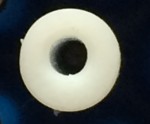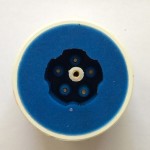In Part 8 of my series on the making of the Wall-Saver safety cylinder, I talked about how I solved (accidentally) several issues with getting cylinders made efficiently. But what I didn’t talk about was how the solution, for reasons that are still unclear to me, created new problems.

At this point in the process, I had 7 molds with dimensions that, if not exactly correct, were very close. I got myself some PTFE rod to use for the centers, and drilled holes in that rod to accommodate the brass sticking up through the center mold. And here I faced problem #1: it’s very hard to drill holds down the center of a rod with a mill. That’s really a job for a lathe, and my lathe was (well, is) still waiting for me to fix it up. (Buying a “project” lathe rather than springing for something ready to go was a huge mistake, but here we are.) So a lot of my holes were a bit off-center, and some radically so. I tried making cylinders with them anyway, and tracked what molds things came out of so I could see what worked and what didn’t.
The first couple of batches had some good and some bad, and they were consistent as to which molds worked and which didn’t. I attributed this to the differences in the PTFE rods, and tried to find some hollow plastic that I could use, with center holes produced perfectly centered at the factory. I couldn’t find anything with the right dimensions, but I was able to make something just as good (I thought): HDPE water pipe with brass tubes down the center. The brass was rigid and straight and fit very nicely over the rods at the center of the molds, and the HDPE wouldn’t stick to cured polyurethane. So it was, or seemed, superior to the off-center rods in every way.

That led to a worse discovery—the off-center holes weren’t the real problem. The bad alignment of the brass center rod was. And it was wildly misaligned! With all questions of concentricity and straightness eliminated by the new design, it was actually easy to see how canted the center rods were. The molds themselves failed to hold them correctly.
That wasn’t true for all the molds, so I thought maybe I’d stick with the 3 “good” molds and just set the “bad” molds aside. But then other problems cropped up. it is essential for accuracy that the center rod sit neatly on top of the silicone protrusion that forms the D-shaped hold for the extractor rod. And for that, it was essential that the center rod slide easily over the brass so that gravity could handle the alignment without extra space or distortion of the rubber. But that loose fit meant that sometimes the rod would be displaced upward by inflowing plastic, resulting in an improper hole—and also that plastic would creep into the space and lock the brass rod to the brass tube. It was difficult to get them apart (sometimes calling for a punch) and difficult to clean out the tube well enough to let it slide freely. Turnaround time for each mold exceeded 30 minutes.
At bottom, the center-rod plan was failing. More than half the molds simply didn’t work because that rod was at an angle, and even the ones that did had a high defect rate and a turnaround time of 30 minutes or more EACH. Unacceptable. Another solution was required.

Leave a Reply